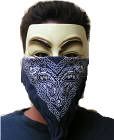House: Criterion Collection
 House is a fever dream of childhood nightmares distilled through the demented lens of visionary (hallucinatory?) director Nobuhiko Obayashi. Utilizing horrific scenarios concocted by his pre-teen daughter, Obayashi constructed his take on a haunted house film and then threw seemingly every camera trick and technique at it, crafting a boldly original and strikingly memorable landmark of ‘70s Japanese cinema.
House is a fever dream of childhood nightmares distilled through the demented lens of visionary (hallucinatory?) director Nobuhiko Obayashi. Utilizing horrific scenarios concocted by his pre-teen daughter, Obayashi constructed his take on a haunted house film and then threw seemingly every camera trick and technique at it, crafting a boldly original and strikingly memorable landmark of ‘70s Japanese cinema.The film follows seven high school damsels with fanciful names such as Gorgeous, Melody, and Kung Fu as they set out on a vacation to the remote home of Gorgeous’ aunt. Her house looks unassuming and safe, and the girls delight in their country vacation until they start disappearing one by one under mysterious circumstances. It’s soon apparent that they’re in incredible danger, but by that time they’re also captives of the house and its otherworldly owner, the spirit of the aunt who died waiting in vain for the return of her deceased soldier husband. Their killings are inventive and filmed in gory detail, but the film never really becomes terrifying due to its trippy nature as well as its groovy 70s soundtrack by pop group Godiego that is often at odds with the creepy visuals. Among the most memorable of those deaths are Melody’s prolonged dismemberment by a grand piano and Prof’s death by drowning in a room filled with blood spewing from a demonic cat painting. Yes, you read that right.
The acting is nothing special, with almost all of the student leads recruited from the modeling ranks of Obayashi’s previous commercial endeavors. I believe Gorgeous was the only professional actress at the time in the group of seven girls, although Kung Fu stuck out for me as the most memorable performance with far more energy than the mostly subdued Gorgeous.
Where the film really leaves its mark is its direction, with Obayashi determined to utilize every conceivable form of visual manipulation to bring his experimental film techniques to this major studio release. Among those techniques were frame and time altering, mixed media incorporation such as fanciful animation (especially prevalent during Melody’s death), literally chopped up film images, and kaleidoscopic backgrounds (with a particularly vivid color wheel filling the screen during Kung Fu’s death battle). The film is like nothing before or since, and surprisingly made a mark at the Japanese box office with younger viewers who welcomed its experimental leanings.
House is presented in its original aspect ration of 1.33:1 in a new, restored high-definition digital transfer created from a 35mm low-contrast print struck from the original camera negative. The mono soundtrack was remastered at 24-bit from an optical track print, and cleaned up with Pro Tools HD. Criterion’s loving restoration of the film results in a pristine presentation that is evident from the first glimpse of the venerable Toho studio logo preceding the feature, looking freshly minted and better than new. As for the merits of disc version, the film is not especially technically impressive on Blu-ray due to the somewhat substandard quality of the original material, but hardcore fans will appreciate the seemingly more intense color and fine detail available in the upgraded format.
The variety of bonus features isn’t extensive, but makes a big impact in the quality department. They include:
• “Constructing a House”, a generous (45 minutes!) new 2010 video interview with director Nobuhiko Obayashi and his daughter
• Emotion, a 40 minute 1966 experimental film by Obayashi that shows some genesis of his filmmaking techniques later used in House
• New video appreciation by director Ti West (House of the Devil), a very brief and unnecessary addition
• Theatrical trailer
• An essay in the Blu-ray case insert by Chuck Stephens regarding the film and the Japanese film industry of the time
House is now available on DVD and Blu-ray.
Labels: horror, Japanese film, Nobuhiko Obayashi







